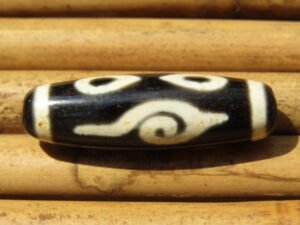4 Eyes Tibetan Conch
 Back
BackThe 4 Eyes Unalome Dzi manifests the qualities of four Bodhisattvas, dedicated individuals in Buddhism pursuing enlightenment to benefit all beings. Bodhisattvas, exemplified by Maitreya, Avalokiteshvara, Manjushri, and Mahasthamaprapta, remain in the world to assist others in escaping the cycle of rebirths (Samsara).
The bead embodies the qualities of four revered Bodhisattvas:
– Maitreya: Compassion and Wisdom
– Avalokiteshvara: Compassion, protector from danger, supreme love
– Manjushri: Wisdom and power of the Buddha, memory, and intelligence
– Mahasthamaprapta: Wisdom and Awareness
Exploring each Bodhisattva’s power is crucial to understanding the Tibetan Dzi 4 Eyes.
—–Maitreya—–
Maitreya, respected across Buddhist schools, is anticipated to reincarnate on Earth as the compassionate Teacher of humanity after achieving enlightenment.
—–Avalokiteshvara—–
Avalokiteshvara, embodying the compassion of all Buddhas, is known as Padmapani or Chenrezig. Kuan Yin in East Asia, revered as the Goddess of Mercy, symbolizes immortality.
—–Manjushri—–
Manjushri, a close disciple of Gautama Buddha, symbolizes higher wisdom. Depicted with a sword against ignorance and a text scroll for knowledge, Manjushri embodies transcendental wisdom.
—–Mahasthamaprapta—–
Mahasthamaprapta, a Buddhist Bodhisattva, personifies the power of wisdom, often portrayed with Avalokiteshvara and Amitabha.
The 4-eye Dzi, infused with the Bodhisattvas’ qualities, enhances wisdom, fulfills desires, and brings luck and prosperity. Its protective function counters evil spirits, ensuring success and longevity. Beneficial for spiritual practitioners, it aids in battling inner demons and shields against negative energy.
The Right-turning Conch Shell
The white conch shell, which spirals towards the right in a clockwise direction, is an ancient Indian attribute of the heroic gods, whose enormous conch shell horns proclaimed their valour and triumphs in war. Vishnu’s fire-emanating conch was named Panchajanya, meaning ‘possessing control over the five classes of beings’. Arjuna’s conch was known as Devadatta, meaning ‘god-given’, whose successful blast struck terror in the enemy. As a battle horn the conch is akin to the modern bugle, as an insignia of power, authority, and sovereignty. Its promising blast is believed to banish evil spirits, avert natural disasters, and scare away harmful creatures. In the Hindu tradition the Buddha is recognized as the ninth of Vishnu’s ten incarnations.
Conch Shell and Buddha’s teaching
The early Buddhists adopted it as a logo of the sovereignty of the Buddha’s teachings. Here the conch symbolizes his fearlessness in proclaiming the truth of the dharma, and his call to awaken and work for the benefit of others. One of the thirty- two major signs of the Buddha’s body is his deep and resonant conch-like voice, which resounds throughout the ten directions of space. In iconography the three conch-like curved lines on his throat embody this sign. As one of the eight auspicious symbols the white conch is usually depicted vertically, often with a silk ribbon threaded through its lower extremity. Its right spiral is indicated by the curve and aperture of its mouth, which faces towards the right. The conch may also appear as a horizontally positioned receptacle for aromatic liquids or perfumes . As a hand-held trait, symbolizing the decree of the Buddha dharma as the feature of speech, the conch is usually held in the left ‘wisdom’ hand of deities.
Today the conch is used in Tibetan Buddhism to call together religious assemblies. During the genuine practice of rituals, it is used both as a musical instrument and as a container for holy water. You will often come across it if you visit the holy areas of Tibet.